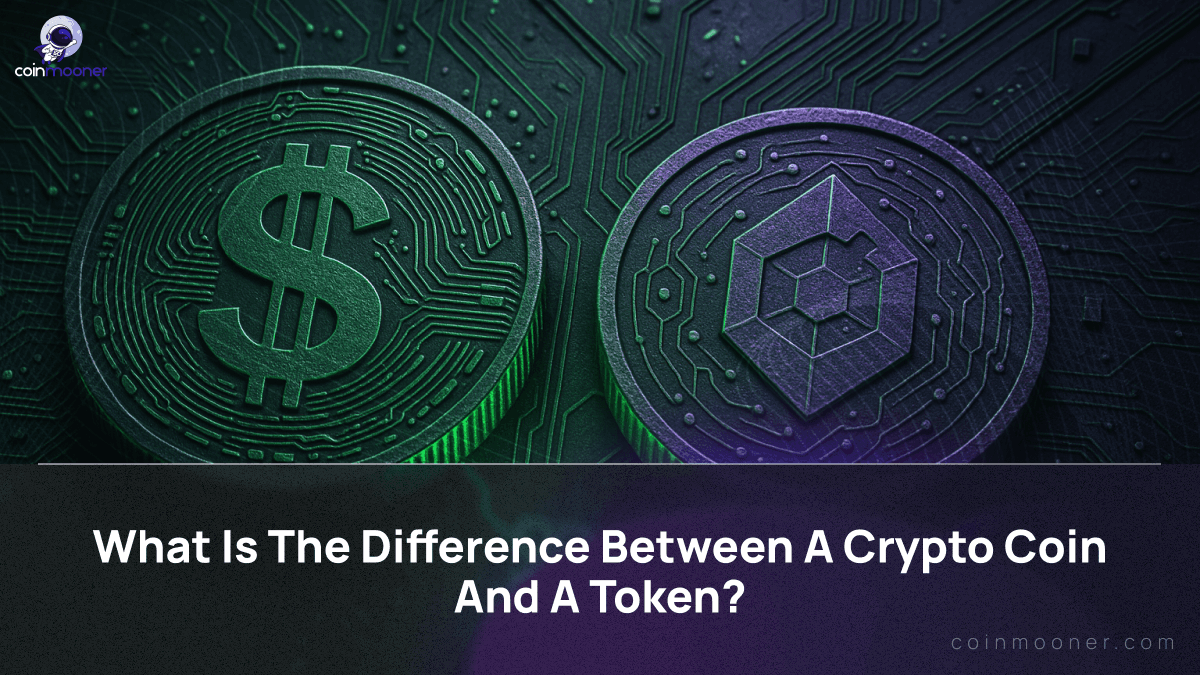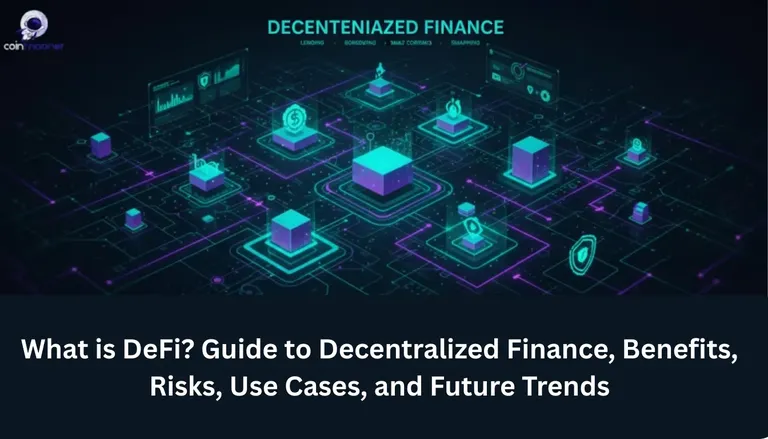What is Crypto Coin: Definition, Types, Value, Regulations, Risks, Security & Environmental Impact

A crypto coin is a digital asset that operates natively on a blockchain, functioning as a medium of exchange, a store of value, or a unit of account within a decentralized network. Built on cryptographic protocols, a crypto coin enables peer-to-peer transactions without reliance on central banks or traditional financial intermediaries, relying instead on distributed consensus mechanisms such as Proof-of-Work or Proof-of-Stake to verify and secure transactions. Market valuation, liquidity, and network activity determine its economic position, while factors such as transaction throughput, network fees, and scalability influence its efficiency and adoption potential in both retail and institutional environments.
The classification of a crypto coin under United States law varies by regulatory body, with agencies such as the Commodity Futures Trading Commission treating certain coins as commodities and the Securities and Exchange Commission applying securities laws to others. Taxation, as defined by the Internal Revenue Service, treats crypto coins as property, requiring accurate record-keeping for capital gains, income from staking or mining, and compliance with anti-money laundering regulations. Technological differences also separate crypto coins from related digital assets such as stablecoins, which maintain value stability through pegging mechanisms, and privacy coins, which focus on transaction confidentiality through advanced cryptography.
The creation and operation of a crypto coin involve blockchain consensus protocols, mining or staking infrastructure, and developer-led innovation to enhance security, efficiency, and scalability. Environmental impact is shaped by the energy consumption of consensus mechanisms, with Proof-of-Work systems consuming significantly more resources than Proof-of-Stake. Key metrics such as market capitalization, active addresses, hash rate, staking ratios, and developer activity guide investors and analysts in assessing utility, security, and adoption trends, while network fees and scalability solutions determine usability for high-volume payments and decentralized finance operations.
Safe and effective use of a crypto coin requires secure wallet management, private key protection, transaction verification, and adherence to legal requirements. Best practices include hardware wallet storage, multi-signature security, two-factor authentication, and avoidance of public network transactions. A precise understanding of glossary terms—including blockchain, wallet, private key, gas fee, and hash rate—enables informed decision-making, while awareness of environmental and regulatory factors ensures responsible participation in the USD 2.4 trillion global cryptocurrency economy.
What is a Crypto Coin?
A crypto coin is a native digital currency that operates on its own blockchain and functions as a decentralized medium of exchange without reliance on a central authority. According to the Massachusetts Institute of Technology Digital Currency Initiative, 2023, a crypto coin uses cryptographic algorithms to secure peer-to-peer transactions, verify transfers, and maintain consensus across a distributed ledger. The blockchain records every transaction in sequential, immutable blocks, ensuring transparency and resistance to tampering. Examples of major crypto coins include Bitcoin, launched in 2009 with a capped supply of 21,000,000 coins and an average block time of 10 minutes, and Ethereum, introduced in 2015 with a dynamic supply model and a 12-second block time. United States regulators such as the Internal Revenue Service classify crypto coins as property for taxation under Notice 2014-21, while the Securities and Exchange Commission applies the Howey Test to assess whether certain digital assets meet the definition of a security. Global market capitalization data from CoinMarketCap, June 2024, shows that crypto coins account for over 55% of the $2.4 trillion cryptocurrency market, highlighting their dominant role in digital asset adoption.
How does a Crypto Coin work?
A crypto coin works by recording and validating transactions on a decentralized blockchain network through a consensus mechanism that ensures data integrity without central control. According to Stanford University Department of Computer Science, 2023, each crypto coin transaction is broadcast to a network of nodes that verify the sender’s balance, apply cryptographic signatures, and package the transaction into a block. The block is then validated using consensus algorithms such as Proof-of-Work, where miners solve computational puzzles, or Proof-of-Stake, where validators lock collateral to propose and attest to new blocks. Once confirmed, the block becomes part of an immutable chain of prior records, creating a transparent and auditable transaction history. Bitcoin, for example, processes approximately one block every 10 minutes with a current hash rate exceeding 500 exahashes per second, while Ethereum finalizes blocks every 12 seconds with validator sets exceeding 1,000,000 participants. In the United States, compliance with Financial Crimes Enforcement Network guidelines requires that crypto coin exchanges and wallet providers implement anti-money laundering procedures, ensuring that network operations meet federal standards while maintaining the trustless nature of peer-to-peer transfers.
What Are the Main Types of Crypto Coins?
The main types of crypto coins are payment coins, platform coins, and privacy coins, each operating on its own blockchain with distinct functions and economic models. According to the Cambridge Centre for Alternative Finance, 2024, crypto coins can be grouped by their primary purpose and technical architecture within the digital asset ecosystem.
Payment coins are designed for peer-to-peer value transfer without intermediaries and are optimized for security, stability, and network uptime. Bitcoin, launched in 2009 with a fixed supply of 21,000,000 coins and a 10-minute average block time, is the dominant payment coin, representing over 48% of total cryptocurrency market capitalization in the United States market segment. Litecoin, introduced in 2011 with a 2.5-minute block time and 84,000,000 supply cap, provides faster transaction confirmation while maintaining similar Proof-of-Work consensus principles.
Platform coins serve as the native currency for blockchain ecosystems that support decentralized applications and smart contracts. Ethereum, launched in 2015 with an average 12-second block time, is the largest platform coin, processing over 1.2 million transactions per day according to on-chain analytics from January 2024. Binance Coin, native to BNB Chain, is used for transaction fees, staking, and network governance, with annual on-chain activity exceeding $500 billion in USD value transfers.
Privacy coins prioritize transaction confidentiality by obscuring sender, receiver, and amount data on the blockchain. Monero uses ring signatures and stealth addresses to achieve untraceable transfers, with a median transaction size of 1.8 kB and dynamic block sizing to handle fluctuating demand. Zcash, launched in 2016, employs zero-knowledge proofs (zk-SNARKs) to enable fully shielded transactions while maintaining regulatory-compliant transparency options for audits and reporting in jurisdictions such as the United States under Financial Crimes Enforcement Network guidelines.
Crypto coins within each category operate under different consensus models, emission schedules, and fee structures, enabling specific use cases while collectively forming the core of the $2.4 trillion global cryptocurrency economy.

What Is the Difference Between a Crypto Coin and a Token?
A crypto coin is a native digital currency operating on its own blockchain, while a token is a digital asset built on an existing blockchain using that network’s infrastructure. According to Massachusetts Institute of Technology Digital Currency Initiative research in 2023, a crypto coin such as Bitcoin functions as the primary unit of value for its blockchain, securing transactions through a consensus mechanism and maintaining a self-contained ledger.
Crypto coins include assets like Bitcoin, which uses the SHA-256 Proof-of-Work protocol with a capped supply of 21,000,000 coins, and Ethereum, which after the Merge operates on Proof-of-Stake with over 1,000,000 validators and a burn mechanism under Ethereum Improvement Proposal 1559. These coins are used for peer-to-peer payments, transaction fees, and network security incentives within their native blockchains.
Tokens, in contrast, are created through smart contracts deployed on an existing blockchain and do not operate an independent ledger. On Ethereum, tokens follow standards such as ERC-20 for fungible assets and ERC-721 for non-fungible assets, relying entirely on Ethereum’s validators, gas fee model, and block production schedule. Examples include USD Coin, a stablecoin pegged to the US dollar with full-reserve backing and regulated issuance in the United States, and Uniswap’s UNI governance token, which grants holders voting rights over protocol upgrades but does not function as Ethereum’s primary currency.
The operational difference between a crypto coin and a token affects scalability, security, and compliance. Crypto coins require dedicated network infrastructure and consensus participants to maintain the blockchain, while tokens share security, block space, and transaction costs with other applications on the host chain. In the United States, regulatory classification also differs—crypto coins like Bitcoin are generally treated as commodities by the Commodity Futures Trading Commission, whereas certain tokens may be evaluated as securities under the Securities and Exchange Commission’s Howey Test, depending on their issuance and utility structure.
What Are the Uses of a Crypto Coin?
The primary uses of a crypto coin are payments, network transaction fees, staking for consensus participation, cross-border value transfer, and as a store of value within a blockchain economy. According to Stanford University Department of Economics, 2024, these functions are enabled by the crypto coin’s native integration into its blockchain’s economic and security model.
Payments are the most recognized function, allowing peer-to-peer transfers without intermediaries such as banks or payment processors. Bitcoin processes over 300,000 transactions daily with settlement finality in approximately 60 minutes, while Litecoin reduces confirmation times to around 10 minutes through a shorter block interval. In the United States retail sector, merchants such as Overstock and Newegg have integrated payment gateways that accept crypto coins via processors like BitPay, enabling USD conversion at the point of sale.
Network transaction fees, also called gas in Ethereum, are paid in the blockchain’s native coin to incentivize miners or validators to include transactions in the next block. Ethereum’s average gas fee in January 2024 was approximately $3.12 per transaction, with fees dynamically adjusting based on block space demand under EIP-1559’s base fee model. These fees secure the network by rewarding participants who validate and store transaction data.
Staking involves locking a certain amount of a Proof-of-Stake crypto coin to participate in block validation and governance. Ethereum requires a minimum of 32 ETH for validator status, with annual staking rewards averaging 4–5% in 2024, while Cardano allows delegation without minimum stake thresholds. Staking directly contributes to blockchain security by aligning validator incentives with honest network behavior.
Cross-border value transfer is a significant use case for reducing settlement times and transaction costs in remittances. According to the World Bank Remittance Data, 2023, average global remittance fees were 6.18% for traditional channels, compared to under 1% for crypto coin-based transfers on networks like Stellar and Ripple. This utility is particularly relevant for US residents sending funds to countries with limited access to correspondent banking.
As a store of value, certain crypto coins, particularly Bitcoin, are held as a hedge against inflation or currency depreciation. Market data from CoinGecko, June 2024, shows that over 65% of Bitcoin’s circulating supply has remained unmoved for more than a year, indicating investor preference for long-term holding. This behavior mirrors gold’s role in traditional finance, with the additional advantage of digital portability and divisibility.
The versatility of a crypto coin’s use cases—spanning consumer payments, decentralized network operations, and macroeconomic hedging—positions it as both a transactional tool and a core asset in the $2.4 trillion global cryptocurrency market.
What Are the Advantages of Using a Crypto Coin?
The main advantages of using a crypto coin are decentralization, low transaction costs, fast settlement, global accessibility, enhanced transparency, and programmable functionality through smart contracts. According to the University of California, Berkeley, Blockchain Lab, 2024, these benefits arise from the technical design of blockchain-based financial systems and their ability to operate without reliance on central intermediaries.
Decentralization removes the need for a central authority, distributing control across a network of nodes that validate and record transactions. In Bitcoin’s network, over 15,000 publicly reachable nodes maintain consensus globally, ensuring resilience against single points of failure and censorship attempts. This structure allows users in the United States and abroad to transact without relying on banks or government-controlled payment infrastructure.
Low transaction costs are achieved by replacing multiple intermediaries with peer-to-peer settlement. On-chain data from January 2024 shows that median Bitcoin transaction fees were under $1.50, while Layer 2 scaling solutions such as the Lightning Network reduced costs to under $0.01 per transaction. This efficiency benefits both microtransactions and high-value transfers by lowering operational expenses compared to credit card networks that average 1.5–3% merchant fees in the US market.
Fast settlement times improve liquidity and operational efficiency. Ethereum finalizes blocks approximately every 12 seconds, enabling near-real-time transaction confirmations for decentralized applications, while Solana processes up to 65,000 transactions per second with sub-second confirmation. These speeds outperform traditional bank transfers, which may take 1–5 business days for cross-border settlements under the SWIFT network.
Global accessibility allows any individual with internet access and a compatible wallet to send or receive funds in crypto coins. This capability bypasses geographical and regulatory barriers that can limit participation in traditional finance. In 2023, World Bank data estimated that 1.4 billion adults worldwide remained unbanked, many of whom can access mobile internet and thus participate in blockchain-based economies.
Enhanced transparency is achieved through public blockchain ledgers that permanently record all transactions. Bitcoin’s blockchain allows any participant to verify transaction histories dating back to the 2009 genesis block, ensuring auditability without requiring trust in a single entity. This transparency supports regulatory compliance in jurisdictions like the United States, where agencies such as the Financial Crimes Enforcement Network use blockchain analytics to monitor illicit activity.
Programmable functionality is available in smart contract-enabled coins such as Ethereum, where transaction logic is embedded directly into the blockchain. This allows automated execution of agreements, decentralized finance applications, and token issuance without intermediaries, creating an expandable ecosystem that supports lending, insurance, and asset trading.
These combined advantages make crypto coins both a technological innovation and an economic alternative, supporting their continued growth in the $2.4 trillion global cryptocurrency market.
What Are the Disadvantages or Risks of a Crypto Coin?
The main disadvantages and risks of a crypto coin are price volatility, regulatory uncertainty, security vulnerabilities, scalability limitations, environmental impact, and irreversible transactions. According to Harvard University Kennedy School of Government, 2024, these factors affect both the adoption rate and the stability of blockchain-based digital currencies in the United States and global markets.
Price volatility is the most visible risk, with crypto coin values subject to rapid fluctuations driven by market sentiment, liquidity depth, and macroeconomic events. Data from CoinMarketCap in 2023 shows that Bitcoin experienced daily price swings exceeding 5% on over 60 occasions, compared to the US dollar’s relative stability under Federal Reserve monetary policy. This volatility can discourage everyday use in payments and introduce portfolio risk for investors.
Regulatory uncertainty impacts compliance requirements, taxation, and market access. In the United States, agencies such as the Securities and Exchange Commission and the Commodity Futures Trading Commission differ in their classification of certain digital assets, leading to legal disputes and enforcement actions. The absence of uniform federal legislation creates operational challenges for exchanges, custodians, and businesses accepting crypto coins.
Security vulnerabilities, including exchange hacks, wallet key theft, and protocol exploits, pose significant threats. Research from the University of Cambridge Centre for Risk Studies, 2023, recorded over $3.8 billion in cryptocurrency-related thefts globally, with social engineering attacks and smart contract bugs as leading causes. Loss of a private key results in permanent loss of access to the associated coins, as blockchain transactions are irreversible by design.
Scalability limitations affect transaction throughput and network efficiency. Bitcoin’s average capacity of around 7 transactions per second and Ethereum’s pre-scaling throughput of roughly 15 transactions per second contrast sharply with Visa’s ability to process over 65,000 transactions per second. Congestion during high demand can lead to elevated transaction fees, as observed during the May 2021 Bitcoin mempool backlog when average fees exceeded $60.
Environmental impact is associated with energy-intensive Proof-of-Work consensus mechanisms. Bitcoin’s estimated annual energy consumption in 2024 was over 120 terawatt-hours, comparable to the electricity usage of a mid-sized country, according to the Cambridge Bitcoin Electricity Consumption Index. Although Proof-of-Stake systems like Ethereum have reduced energy usage by over 99%, Proof-of-Work remains prevalent among major payment-focused coins.
Irreversible transactions, while supporting finality and preventing chargeback fraud, also mean that user errors, such as sending funds to an incorrect address, result in permanent loss without recourse. This design choice increases the importance of secure transaction verification and wallet management practices.
These disadvantages and risks illustrate the importance of robust security measures, regulatory awareness, and user education when engaging with crypto coins, ensuring informed participation in the evolving $2.4 trillion cryptocurrency ecosystem.
How Is a Crypto Coin Created?
A crypto coin is created through a blockchain network’s native issuance process, which may involve mining in Proof-of-Work systems or minting in Proof-of-Stake systems, following predetermined protocol rules. According to the Massachusetts Institute of Technology Digital Currency Initiative, 2024, the creation process is embedded in the blockchain’s consensus mechanism and economic model, ensuring predictable supply and secure distribution.
In Proof-of-Work blockchains such as Bitcoin, new coins are issued as rewards to miners who validate transactions and solve complex cryptographic puzzles using the SHA-256 hashing algorithm. Each valid block currently awards 6.25 BTC, a figure that decreases by 50% approximately every four years during the Bitcoin halving event, with the next reduction to 3.125 BTC scheduled for 2024. Mining requires substantial computational resources and electricity, contributing to a network hash rate exceeding 500 exahashes per second as of mid-2024. The supply is capped at 21,000,000 coins, ensuring scarcity similar to finite commodities like gold.
In Proof-of-Stake blockchains such as Ethereum post-Merge, coins are created through minting, where validators lock a minimum stake—32 ETH for Ethereum—to propose and attest to new blocks. The protocol issues new coins as staking rewards, adjusted dynamically based on the total amount of staked coins, validator performance, and network conditions. Staking consumes over 99% less energy than mining while maintaining security through economic penalties for dishonest validators.
Some blockchains implement hybrid or alternative issuance models. Dash combines Proof-of-Work mining with masternode rewards, splitting new coin issuance between miners, masternodes, and a governance treasury. Monero maintains a “tail emission” of 0.6 XMR per block indefinitely to incentivize miners after the main supply cap is reached, ensuring continuous network security.
In all systems, the creation of a crypto coin follows a transparent, algorithmic schedule defined in the blockchain’s codebase, which is publicly auditable and resistant to arbitrary changes. This predictable issuance is a key factor in economic modeling, influencing inflation rates, transaction fee structures, and long-term valuation in the $2.4 trillion global cryptocurrency market.
What Gives a Crypto Coin Value?
A crypto coin derives value from its scarcity, utility within its blockchain ecosystem, security provided by its consensus mechanism, market demand, and trust in its underlying protocol. According to the University of Cambridge Judge Business School, 2024, these factors interact to establish both the economic and perceived worth of a crypto coin in global and US markets.
Scarcity is a primary driver, as limited supply creates competition for ownership. Bitcoin’s fixed maximum of 21,000,000 coins and Ethereum’s burn mechanism under Ethereum Improvement Proposal 1559 reduce circulating supply over time, influencing long-term price appreciation. On-chain data from Glassnode, June 2024, shows that over 65% of Bitcoin’s supply has remained unmoved for more than a year, indicating strong holder conviction and reduced available liquidity.
Utility directly impacts demand by determining how essential the coin is to its blockchain’s operations. Ethereum is required for paying gas fees, executing smart contracts, and interacting with decentralized applications, while Binance Coin is integral for discounted trading fees, staking, and governance on the BNB Chain. Coins with high transaction throughput, low fees, and unique features often see stronger adoption in both retail and institutional use cases.
Security provided by the consensus mechanism protects the network from attacks and reinforces confidence in the coin’s integrity. Bitcoin’s Proof-of-Work network, with a hash rate exceeding 500 exahashes per second in 2024, requires significant economic expenditure to compromise, while Ethereum’s Proof-of-Stake system uses over 1,000,000 validators and slashing penalties to deter malicious actors.
Market demand reflects adoption levels, liquidity availability, and macroeconomic conditions. In 2023, US-based institutional investments in Bitcoin through products like the Grayscale Bitcoin Trust exceeded $25 billion, contributing to price stability and wider recognition. Demand is also influenced by speculative trading, regulatory developments, and integration into payment systems by companies such as PayPal and Square.
Trust in the underlying protocol and its governance model ensures that users believe in the network’s longevity and resistance to arbitrary changes. Open-source codebases, community-driven development, and transparent monetary policies foster this trust. For example, Bitcoin’s consensus rules have remained fundamentally unchanged since its 2009 launch, while maintaining decentralized governance among thousands of contributors worldwide.
The combination of scarcity, functional utility, robust security, active demand, and strong protocol trust sustains a crypto coin’s value in the $2.4 trillion global cryptocurrency market, influencing both its role as a medium of exchange and its position as a long-term investment asset.

How Do US Regulations Classify a Crypto Coin?
US regulations classify a crypto coin based on its function, issuance, and use, primarily under the frameworks of the Commodity Futures Trading Commission (CFTC), Securities and Exchange Commission (SEC), and Internal Revenue Service (IRS). According to the Congressional Research Service, 2024, classification depends on whether the asset functions as a commodity, a security, or property for taxation, with some coins also subject to the Financial Crimes Enforcement Network (FinCEN) oversight.
The CFTC generally treats crypto coins such as Bitcoin and Ethereum as commodities under the Commodity Exchange Act, giving the agency enforcement authority over fraud and market manipulation in spot and derivatives markets. This classification aligns with their role as decentralized assets without an issuer promising future returns.
The SEC applies the Howey Test to determine whether a crypto coin qualifies as a security. While most established crypto coins used purely as mediums of exchange are not considered securities, tokens or coins issued through initial coin offerings or with profit-sharing promises may fall under securities regulation. SEC Chair Gary Gensler reaffirmed in 2023 that Bitcoin does not meet the Howey Test criteria, while other assets undergo case-by-case evaluation.
The IRS classifies all crypto coins as property for federal tax purposes under Notice 2014-21. This means gains from selling, trading, or spending a crypto coin are subject to capital gains tax, while mined or staked coins are treated as taxable income at their fair market value on the date of receipt. In 2023, the IRS expanded reporting requirements to include all digital asset transactions over $10,000, aligning with anti-money laundering laws.
FinCEN considers crypto coin exchanges and custodial wallet providers as money services businesses (MSBs) under the Bank Secrecy Act. This requires compliance with anti-money laundering (AML) and know-your-customer (KYC) procedures, suspicious activity reporting, and registration with the US Department of the Treasury.
The combined regulatory approach means that a crypto coin’s classification in the United States is not uniform but rather a multi-agency interpretation based on its characteristics and usage, creating a layered compliance environment within the $2.4 trillion global cryptocurrency economy.
How Can You Buy and Store Crypto Coins?
You can buy a crypto coin through cryptocurrency exchanges, peer-to-peer marketplaces, or Bitcoin ATMs, and store it in digital wallets that may be custodial or non-custodial. According to the University of Pennsylvania Wharton School Blockchain and Digital Asset Project, 2024, secure acquisition and storage depend on selecting regulated platforms and implementing strong key management practices.
Buying a crypto coin in the United States commonly occurs on regulated cryptocurrency exchanges such as Coinbase, Kraken, and Gemini, which comply with Securities and Exchange Commission, Commodity Futures Trading Commission, and Financial Crimes Enforcement Network requirements. These platforms allow purchases via bank transfers, debit cards, and in some cases PayPal, with identity verification under Know Your Customer regulations. Bitcoin ATMs, available in over 36,000 US locations as of 2024, enable cash purchases by scanning a wallet QR code, while peer-to-peer marketplaces like Paxful and LocalBitcoins match buyers and sellers directly, often using escrow services to prevent fraud.
Storing a crypto coin securely involves choosing between custodial and non-custodial wallets. Custodial wallets, offered by exchanges or institutional custodians, hold private keys on behalf of the user, simplifying access and recovery but introducing counterparty risk if the custodian is breached. Non-custodial wallets give users full control of their private keys, which are required to authorize any transaction, with security dependent on safe key storage.
Non-custodial wallets include hardware wallets such as Ledger Nano X and Trezor Model T, which store keys offline to prevent online attacks, and software wallets like Exodus and Electrum, which run on desktops or mobile devices. Hardware wallets are recommended for long-term storage of significant holdings, while software wallets offer convenience for frequent transactions. Paper wallets, which record keys on a physical medium, are less common but provide complete offline storage when generated securely.
Multi-signature wallets add an extra security layer by requiring multiple private keys to authorize transactions, a method used by institutional investors and corporate treasuries. In 2023, on-chain data from BitGo showed that multi-signature setups accounted for over 20% of institutional Bitcoin custody.
Whether buying or storing, protecting a crypto coin requires careful consideration of platform trustworthiness, regulatory compliance, private key security, and backup strategies, ensuring safe participation in the $2.4 trillion global cryptocurrency economy.
What Is the Future of Crypto Coins?
The future of crypto coins involves wider institutional adoption, integration into traditional financial systems, technological advancements in scalability and privacy, increased regulatory clarity, and continued global market growth. According to the Massachusetts Institute of Technology Digital Currency Initiative, 2024, these developments are driven by both technical innovation and evolving economic conditions.
Institutional adoption is expanding as major financial institutions integrate crypto coins into investment portfolios and payment systems. In the United States, BlackRock’s Bitcoin exchange-traded fund filings in 2023 signaled a shift toward mainstream acceptance, while Fidelity and Charles Schwab launched cryptocurrency trading services for retail and institutional clients. Such moves increase market liquidity and legitimacy, contributing to a maturing asset class.
Integration with traditional finance is accelerating through central bank digital currency (CBDC) research and private sector partnerships. Payment processors like PayPal and Visa have enabled direct crypto coin transactions, allowing users to convert holdings into USD at the point of sale. Stablecoins pegged to the US dollar, such as USD Coin, are increasingly used for cross-border settlements, reducing reliance on correspondent banking networks.
Technological advancements focus on improving scalability, transaction speed, and privacy. Ethereum’s transition to Proof-of-Stake and ongoing sharding upgrades aim to process thousands of transactions per second, while Layer 2 solutions such as the Bitcoin Lightning Network enable near-instant, low-cost payments. Privacy-focused innovations like zero-knowledge proofs are expanding confidential transaction capabilities without sacrificing regulatory compliance.
Regulatory clarity is expected to shape future market stability. In the US, proposed legislation such as the Digital Asset Market Structure Bill seeks to define jurisdictional boundaries between the Securities and Exchange Commission and the Commodity Futures Trading Commission, standardizing classification and compliance requirements for crypto coins. This legal framework could reduce uncertainty for developers, investors, and exchanges, fostering long-term growth.
Global market growth projections remain strong, with research from PwC’s Crypto Market Outlook, 2024, forecasting the cryptocurrency market capitalization to exceed $5 trillion by 2030, driven by emerging market adoption, DeFi expansion, and increased tokenization of real-world assets.
The convergence of institutional trust, technological maturity, legal certainty, and broader economic utility positions crypto coins as both a transformative financial technology and a central component of the evolving $2.4 trillion global digital asset ecosystem.
What Consensus Mechanisms Secure a Crypto Coin?
The main consensus mechanisms that secure a crypto coin are Proof-of-Work (PoW), Proof-of-Stake (PoS), and hybrid models, each providing network security, transaction validation, and protection against double-spending through decentralized agreement. According to Stanford University Department of Computer Science, 2024, these mechanisms determine how participants in a blockchain agree on the validity of transactions and maintain the integrity of the ledger.
Proof-of-Work secures a crypto coin by requiring miners to solve computationally difficult cryptographic puzzles using algorithms such as SHA-256 for Bitcoin or Scrypt for Litecoin. Successful miners add new blocks to the blockchain and receive block rewards, with difficulty adjustments maintaining consistent block times—10 minutes for Bitcoin and 2.5 minutes for Litecoin. This system provides strong security through high energy expenditure and network hash rate, which for Bitcoin exceeded 500 exahashes per second in 2024, making network attacks economically prohibitive.
Proof-of-Stake secures a crypto coin by selecting validators based on the amount of the native coin staked as collateral. Ethereum, after its 2022 Merge upgrade, uses a PoS model where validators must stake a minimum of 32 ETH to propose and attest to blocks, with rewards and penalties (slashing) incentivizing honest participation. PoS consumes over 99% less energy than PoW while achieving block finality in approximately 12 seconds. Other PoS-based coins such as Cardano and Solana offer variable staking requirements, adaptive rewards, and faster transaction throughput.
Hybrid consensus models combine elements of PoW and PoS or incorporate additional verification layers. Dash uses PoW mining to create new blocks and a masternode PoS layer for transaction validation and governance decisions. Decred implements PoW for block creation and PoS voting for block acceptance, balancing security with decentralized decision-making.
Some specialized consensus variants secure niche crypto coins. Delegated Proof-of-Stake (DPoS), used by EOS and TRON, involves stakeholders voting for a limited number of block producers, enabling high transaction throughput at the cost of reduced validator decentralization. Proof-of-Authority (PoA), used in certain private blockchain environments, relies on a set of approved validators, offering fast block times but requiring trust in known entities.
The choice of consensus mechanism affects a crypto coin’s security, scalability, energy efficiency, and decentralization. In the $2.4 trillion global cryptocurrency market, consensus design remains a defining factor in determining a coin’s long-term viability and adoption.
How Can We Store and Secure a Crypto Coin?
A crypto coin can be stored in custodial or non-custodial digital wallets, and secured through private key protection, multi-factor authentication, offline storage, and backup strategies. According to the University of California, Berkeley Blockchain X-Lab, 2024, effective storage and security depend on controlling access to cryptographic keys, since possession of a private key grants full spending authority over the associated crypto coin balance.
Custodial wallets, offered by cryptocurrency exchanges and institutional custodians, store private keys on behalf of the user. These wallets provide convenience and integrated trading features but introduce counterparty risk if the custodian is hacked or becomes insolvent. Regulated US exchanges such as Coinbase, Kraken, and Gemini mitigate these risks through insurance policies, segregated cold storage, and compliance with Financial Crimes Enforcement Network anti-money laundering requirements.
Non-custodial wallets give users complete control over their private keys and are classified into hardware, software, and paper wallets. Hardware wallets such as Ledger Nano X and Trezor Model T store keys offline, protecting them from online attacks and malware. Software wallets like Electrum and Exodus run on desktop or mobile devices, enabling daily spending but requiring secure device practices. Paper wallets, which record keys or QR codes on a physical medium, provide offline storage when generated securely but are vulnerable to physical damage or loss.
Security practices include enabling multi-factor authentication for online wallet accounts, maintaining offline backups of seed phrases in tamper-proof storage, and using multi-signature wallets that require approval from multiple private keys before authorizing transactions. In 2023, institutional custody provider BitGo reported that over 20% of Bitcoin held in US-based institutional accounts used multi-signature configurations to reduce single-point key compromise risks.
Offline storage, also known as cold storage, is critical for safeguarding large holdings. This involves keeping private keys in devices or environments completely disconnected from the internet, such as air-gapped computers or hardware wallets stored in secure facilities. Periodic integrity checks and secure retrieval protocols ensure coins remain accessible when needed without exposing them to online threats.
By combining secure wallet selection, rigorous private key management, layered authentication, and geographically distributed backups, we can protect crypto coins from both cyberattacks and physical risks, ensuring safe participation in the $2.4 trillion global cryptocurrency economy.
How Do Network Fees and Scalability Affect a Crypto Coin?
Network fees and scalability affect a crypto coin by determining transaction cost-efficiency, processing capacity, and long-term adoption in both retail and institutional markets. According to Massachusetts Institute of Technology Digital Currency Initiative research in 2024, these factors influence user experience, payment utility, and competitiveness of blockchain-based assets.
Network fees, also referred to as transaction fees or gas fees, represent the payment in the native crypto coin to validators or miners for including transactions in a block. Bitcoin applies a fee model based on transaction size in bytes and network demand, which in May 2023 saw the average fee rise above USD 30 during a congestion spike. Ethereum applies a dynamic base fee model under Ethereum Improvement Proposal 1559 with a median base fee of USD 3.12 in January 2024, while Layer 2 rollups such as Arbitrum and Optimism lowered costs to under USD 0.10 by batching and compressing transactions before settlement on the main chain.
Scalability defines the number of transactions a blockchain can process per second without sacrificing decentralization or security. Bitcoin processes approximately 7 transactions per second (TPS) with a 10-minute block time, Ethereum processes around 15 TPS on its base layer, Solana processes over 65,000 TPS with sub-second finality, and Algorand achieves approximately 6,000 TPS with 4.5-second block times. Scaling technologies, including Bitcoin’s Lightning Network and Ethereum’s sharding roadmap, address throughput constraints by enabling off-chain or parallelized processing while maintaining final settlement security.
High network fees and low scalability limit crypto coin suitability for micropayments, high-frequency trading, and real-time settlement. In the United States, payment processors integrating crypto coins—such as PayPal and Visa—prioritize networks or scaling solutions that maintain transaction costs under USD 0.05 to meet consumer expectations. Data from Electric Capital’s Developer Report 2024 indicates that over 38% of new blockchain protocol development focused on scalability enhancements, reflecting its priority for sustainable adoption.
In the USD 2.4 trillion global cryptocurrency market, maintaining low, predictable network fees alongside scalable infrastructure ensures that a crypto coin remains viable for high-volume transactions, decentralized finance operations, and cross-border payment settlements under varying network load conditions.
What Key Metrics Help Us Evaluate the Value and Utility of a Crypto Coin?
Key metrics that help evaluate the value and utility of a crypto coin include market capitalization, trading volume, active addresses, transaction throughput, network hash rate or staking ratio, developer activity, and real-world use cases. According to University of Cambridge Centre for Alternative Finance research in 2024, these indicators provide quantifiable insight into a crypto coin’s adoption, security, and economic relevance.
Market capitalization measures the total value of a crypto coin by multiplying its circulating supply by its current market price, with Bitcoin exceeding USD 1.2 trillion and Ethereum surpassing USD 450 billion in April 2024, making them the most economically dominant assets in the sector. Trading volume, reported over 24-hour or 30-day periods, indicates liquidity and market activity, where high volume reduces slippage and improves price stability for large trades.
Active addresses track the number of unique blockchain addresses participating in transactions daily, signaling user adoption and network utility. For example, Bitcoin averages over 900,000 daily active addresses, while Ethereum exceeds 1.1 million, reflecting extensive on-chain engagement. Transaction throughput, measured in transactions per second (TPS), and average confirmation time reveal a network’s processing capacity and efficiency, with Solana achieving over 65,000 TPS and Ethereum Layer 2 solutions delivering sub-second settlement.
Network security is measured differently depending on the consensus mechanism: in Proof-of-Work systems such as Bitcoin, hash rate—exceeding 500 exahashes per second in mid-2024—reflects computational security; in Proof-of-Stake systems such as Ethereum, staking ratio—over 23% of total supply staked—indicates validator participation and economic security.
Developer activity, tracked through GitHub commits, protocol upgrades, and ecosystem funding, demonstrates the pace of technical innovation. Electric Capital’s 2024 Developer Report ranked Ethereum first in active monthly developers at over 5,900, followed by Polkadot and Cosmos, indicating strong community-driven growth.
Real-world use cases, including merchant acceptance, DeFi integration, remittance processing, and tokenization of assets, confirm whether a crypto coin functions beyond speculative investment. For example, USD Coin’s daily settlement volume in cross-border payments surpassed USD 6 billion in Q1 2024, reflecting tangible economic utility.
Evaluating these metrics collectively allows for a comprehensive assessment of a crypto coin’s performance, resilience, and adoption trajectory within the USD 2.4 trillion global cryptocurrency economy.
What Are the Legal and Tax Considerations for a Crypto Coin in the United States?
Legal and tax considerations for a crypto coin in the United States include federal classification, regulatory compliance, anti-money laundering obligations, and Internal Revenue Service reporting requirements. According to the Congressional Research Service Digital Assets Report in 2024, these frameworks define how individuals, businesses, and institutions can hold, trade, and report crypto coins.
Federal classification determines which agencies have jurisdiction over a crypto coin. The Commodity Futures Trading Commission treats crypto coins such as Bitcoin and Ethereum as commodities under the Commodity Exchange Act, while the Securities and Exchange Commission classifies certain digital assets as securities based on the Howey Test. The Financial Crimes Enforcement Network regulates exchanges and custodians as money services businesses, requiring registration, anti-money laundering programs, and suspicious activity reporting.
Tax treatment under the Internal Revenue Service Notice 2014-21 defines crypto coins as property for federal tax purposes. Disposing of a crypto coin through sale, trade, or purchase triggers capital gains or losses, with short-term gains taxed at ordinary income rates and long-term gains taxed at capital gains rates. Mining rewards and staking income are classified as taxable income at fair market value upon receipt, and a subsequent sale generates a separate capital gains event.
Reporting obligations include the requirement to answer the digital asset question on Form 1040, maintain detailed transaction records, and file Form 8949 and Schedule D for capital gains. Businesses accepting crypto coins must report income in U.S. dollars at the time of receipt and may face additional state-level reporting obligations.
State regulations vary, with New York requiring a BitLicense for most virtual currency activities, and Wyoming recognizing decentralized autonomous organizations as legal entities under state law. As of 2024, over 15 U.S. states had enacted blockchain and digital asset legislation, influencing how crypto coins can be issued and transacted locally.
Compliance failures can result in civil penalties, tax audits, or criminal charges. The Internal Revenue Service increased digital asset enforcement actions in 2023 through its Operation Hidden Treasure program, targeting unreported gains and offshore wallet holdings.
Understanding these legal and tax frameworks ensures that transactions involving a crypto coin remain compliant, minimizing regulatory risk while supporting sustainable adoption in the USD 2.4 trillion global cryptocurrency market.

How Does a Crypto Coin Impact the Environment?
A crypto coin impacts the environment through the energy consumption, carbon emissions, and electronic waste generated by its consensus mechanism and mining or validation process. According to University of Cambridge Centre for Alternative Finance data in 2024, environmental effects vary significantly between Proof-of-Work and Proof-of-Stake networks due to their differing energy requirements.
Proof-of-Work crypto coins, such as Bitcoin and Litecoin, require miners to perform intensive computational work using application-specific integrated circuits or graphics processing units, resulting in high electricity usage. Bitcoin’s estimated annual energy consumption in 2024 exceeded 120 terawatt-hours, comparable to the electricity usage of a mid-sized country such as Argentina, with a carbon footprint of approximately 70 million metric tons of CO₂. The geographical concentration of mining in regions with coal-based energy grids intensifies emissions, although renewable-powered mining initiatives in Texas, Iceland, and Canada are increasing their share.
Proof-of-Stake crypto coins, such as Ethereum post-Merge, Cardano, and Solana, use validator selection based on staked holdings rather than computational work, reducing energy usage by over 99% compared to Proof-of-Work systems. Ethereum’s shift in September 2022 cut its energy consumption from 78 terawatt-hours per year to approximately 0.01 terawatt-hours per year, lowering its carbon emissions proportionally.
Electronic waste from hardware obsolescence is another environmental consideration, with Bitcoin mining generating an estimated 30 kilotons of e-waste annually due to rapid ASIC replacement cycles. In contrast, Proof-of-Stake systems use standard server hardware with significantly longer lifespans, reducing hardware turnover and waste generation.
Sustainability initiatives include carbon offset programs, renewable energy-powered mining farms, and blockchain protocols integrating energy efficiency targets into governance models. For example, the Crypto Climate Accord aims to achieve net-zero emissions for the entire cryptocurrency sector by 2030.
Evaluating a crypto coin’s environmental impact requires analyzing its consensus model, energy source mix, hardware requirements, and sustainability commitments, as these factors collectively shape its ecological footprint within the USD 2.4 trillion global cryptocurrency economy.
How Do Stablecoins and Privacy Coins Compare to a Crypto Coin?
Stablecoins and privacy coins differ from a crypto coin in price stability mechanisms and transaction anonymity features, while sharing the underlying blockchain-based architecture. According to Massachusetts Institute of Technology Digital Currency Initiative research in 2024, these distinctions influence market usage, regulatory treatment, and adoption patterns.
A crypto coin, such as Bitcoin or Ethereum, operates as a native blockchain asset with a market value determined entirely by supply and demand, resulting in high price volatility. Stablecoins, such as USD Coin, Tether, and Dai, are designed to maintain a stable value by pegging to fiat currencies like the U.S. dollar or to commodities such as gold, using collateral reserves, algorithmic supply adjustments, or a combination of both. In 2024, USD Coin maintained a 1:1 peg to the dollar with over USD 28 billion in circulating supply, serving primarily in trading, remittances, and decentralized finance settlements.
Privacy coins, such as Monero and Zcash, prioritize transaction confidentiality through cryptographic methods like ring signatures, stealth addresses, and zero-knowledge proofs. These privacy enhancements obscure wallet addresses, transaction amounts, and participant identities, offering stronger financial privacy compared to transparent-ledger crypto coins. For example, Monero processes over 30,000 private transactions daily, with each transaction unlinkable to previous activity, whereas Bitcoin transactions remain publicly traceable on-chain.
Regulatory treatment varies: stablecoins face scrutiny from the U.S. Department of the Treasury and potential regulation under proposed stablecoin legislation, focusing on reserve transparency and systemic risk mitigation. Privacy coins encounter tighter restrictions, with some exchanges delisting them in jurisdictions requiring strict anti-money laundering compliance, including enforcement by the Financial Crimes Enforcement Network.
Functionally, stablecoins are preferred for price-stable transactions and cross-border payments, privacy coins are chosen for confidential transfers, and standard crypto coins are favored for decentralized store-of-value and smart contract applications. In the USD 2.4 trillion global cryptocurrency economy, these categories coexist, each serving distinct transactional, investment, and regulatory niches while leveraging blockchain security and decentralization.
What Best Practices Help Us Use a Crypto Coin Safely?
Best practices that help use a crypto coin safely include secure wallet management, private key protection, transaction verification, and compliance with regulatory requirements. According to University of California Berkeley Blockchain X-Lab research in 2024, following structured security protocols reduces the risk of theft, fraud, and accidental loss of digital assets.
Secure wallet management begins with choosing between custodial wallets, provided by regulated exchanges such as Coinbase or Kraken, and non-custodial wallets, including hardware options like Ledger Nano X and Trezor Model T, or software wallets like Electrum and Exodus. Hardware wallets store private keys offline, preventing exposure to malware, while custodial wallets require the user to assess the provider’s security standards, insurance coverage, and cold storage policies.
Private key protection is critical because control over the key equals control over the crypto coin. Best practices include generating keys in an offline environment, storing seed phrases in tamper-proof physical locations, and avoiding digital backups vulnerable to hacking. Multi-signature wallets, requiring approvals from multiple keys before processing a transaction, provide an additional security layer against unauthorized transfers.
Transaction verification involves double-checking wallet addresses, ensuring correct network selection, and reviewing transaction fees before confirmation. Blockchain explorers can confirm transaction status and block inclusion, reducing the likelihood of errors or phishing attacks.
Regulatory compliance includes adhering to anti-money laundering (AML) and know-your-customer (KYC) requirements when using exchanges, reporting taxable events to the Internal Revenue Service under Notice 2014-21, and maintaining accurate records of all transactions, including timestamps, values in U.S. dollars, and counterparties.
Additional security measures include enabling two-factor authentication for exchange accounts, regularly updating wallet firmware, and avoiding public Wi-Fi for transactions. Cold storage solutions are recommended for long-term holdings, while hot wallets are suitable for small amounts intended for frequent use.
By implementing layered security measures, verifying transactions rigorously, and meeting legal obligations, users maintain safe control over a crypto coin while participating securely in the USD 2.4 trillion global cryptocurrency economy.
How Do We Avoid Scams and Fraud With a Crypto Coin?
Avoiding scams and fraud with a crypto coin requires identity verification of counterparties, secure storage of private keys, thorough due diligence on platforms, and vigilance against phishing attempts. According to Federal Trade Commission Consumer Protection Data Spotlight in 2024, over USD 1.4 billion in cryptocurrency-related fraud losses were reported in the United States in the prior 12 months, with investment scams and fake exchanges being the most common.
Identity verification includes using only regulated exchanges and peer-to-peer platforms that comply with Financial Crimes Enforcement Network (FinCEN) registration and enforce know-your-customer (KYC) protocols. Platforms such as Coinbase, Kraken, and Gemini maintain insurance coverage and independent security audits, reducing counterparty risk.
Secure storage of private keys is essential, as loss or theft of keys results in irreversible loss of the associated crypto coin. Best practices include hardware wallet storage in offline environments, the use of multi-signature configurations, and physical backup of seed phrases in tamper-proof formats. Avoiding cloud storage or unsecured devices prevents unauthorized access.
Due diligence before investing in or transacting with a crypto coin project involves reviewing the project’s whitepaper, verifying developer credentials, checking blockchain explorer data for activity, and assessing community engagement through reputable channels. Warning signs of fraudulent projects include guaranteed returns, pressure to invest quickly, and lack of transparent technical documentation.
Phishing prevention requires confirming website URLs, avoiding unsolicited links, and using browser extensions or bookmark verification to access exchanges. Scammers frequently impersonate support staff on social media or messaging platforms to request private keys or login credentials, which legitimate entities never ask for.
Additional safeguards include enabling two-factor authentication, setting withdrawal address whitelists on exchanges, and monitoring blockchain transactions through public explorers to detect unauthorized activity. Using decentralized reputation systems and escrow services for high-value trades further reduces exposure to fraud.
By combining regulatory-compliant platform use, strong key management, rigorous project verification, and anti-phishing measures, users significantly reduce the risk of scams while transacting in the USD 2.4 trillion global cryptocurrency economy.
What Glossary Terms Help Us Understand a Crypto Coin?
Glossary terms that help understand a crypto coin include blockchain, wallet, private key, public key, consensus mechanism, mining, staking, gas fee, market capitalization, liquidity, and hash rate. According to the University of Cambridge Centre for Alternative Finance 2024 report, mastering these definitions improves comprehension of how crypto coins operate within the global digital asset ecosystem.
The key glossary terms are given below:
Blockchain: A distributed digital ledger that records crypto coin transactions in immutable blocks, secured through cryptography and validated by network participants.
Wallet: A software application or hardware device that stores the private and public keys required to access and transfer a crypto coin.
Private Key : cryptographic code granting full control over the crypto coin associated with its matching public key, requiring secure offline storage.
Public Key: A cryptographic identifier derived from the private key, used to receive crypto coins on a blockchain network.
Consensus Mechanism: The protocol determining how transactions are validated and added to the blockchain, such as Proof-of-Work or Proof-of-Stake.
Mining : The process in Proof-of-Work networks where computational power is used to solve cryptographic puzzles and add new blocks to the blockchain.
Staking: The process in Proof-of-Stake networks where participants lock up crypto coins to validate transactions and earn rewards.
Gas Fee: The transaction fee paid to validators or miners to process operations on a blockchain, measured in the native crypto coin.
Market Capitalization: The total value of a crypto coin’s circulating supply, calculated by multiplying price by circulating quantity.
Liquidity: The ease with which a crypto coin can be bought or sold in the market without affecting its price.
Hash Rate: The total computational power used to secure a Proof-of-Work blockchain, measured in hashes per second.
Understanding these glossary terms ensures accurate interpretation of technical documentation, regulatory guidelines, and market analytics when evaluating or using a crypto coin in the USD 2.4 trillion global cryptocurrency economy.
Summing Up
A crypto coin is a blockchain-native digital asset whose value, utility, and long-term adoption depend on technological design, market dynamics, regulatory frameworks, and security practices. Its role in the global financial system is shaped by consensus mechanisms, transaction efficiency, scalability solutions, and its integration into commerce, decentralized finance, and cross-border payments. Regulatory classification in the United States—whether as a commodity, security, or other digital asset—determines compliance obligations, while Internal Revenue Service property-based taxation defines how gains, losses, and income must be reported.
Environmental impact, particularly in Proof-of-Work systems, underscores the importance of sustainable energy use and consensus innovation, while emerging models like Proof-of-Stake demonstrate significant reductions in carbon footprint and resource consumption. Market analysis relies on metrics such as market capitalization, transaction volume, liquidity, hash rate, and developer activity to assess adoption potential and network resilience. The differences between crypto coins, stablecoins, and privacy coins reveal unique value propositions—ranging from volatility exposure to price stability and transaction anonymity—each serving distinct user needs.
Security and safe usage demand disciplined practices: hardware wallet storage, private key protection, multi-signature authorization, platform due diligence, and strict avoidance of phishing or scam tactics. Glossary mastery—from blockchain and wallet to gas fees and hash rates—enables informed participation and risk management. By aligning technological understanding with regulatory compliance, sustainability awareness, and layered security, participants in the USD 2.4 trillion cryptocurrency economy can maximize the benefits of a crypto coin while minimizing operational, legal, and environmental risks.










